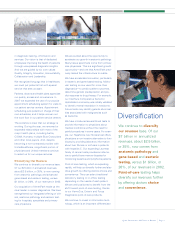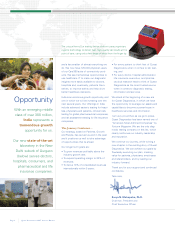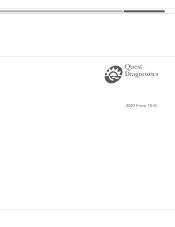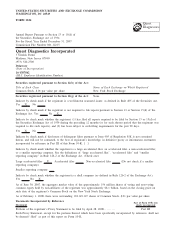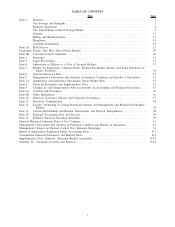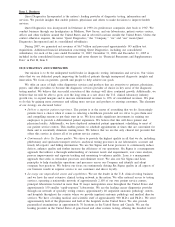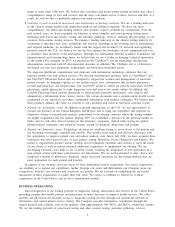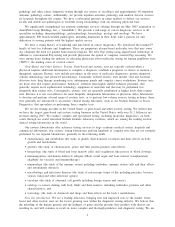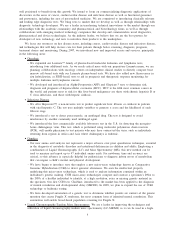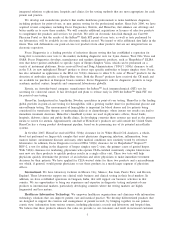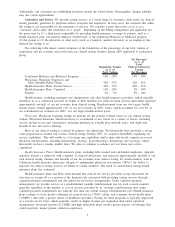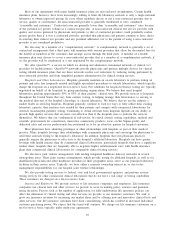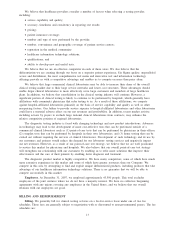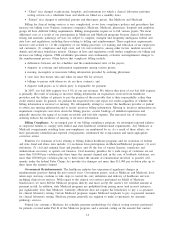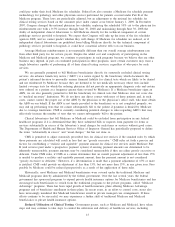Quest Diagnostics 2007 Annual Report Download - page 14
Download and view the complete annual report
Please find page 14 of the 2007 Quest Diagnostics annual report below. You can navigate through the pages in the report by either clicking on the pages listed below, or by using the keyword search tool below to find specific information within the annual report.
well positioned to benefit from this growth. We intend to focus on commercializing diagnostic applications of
discoveries in the areas of cancer, cardiovascular disease and infectious disease as well as functional genomics
and proteomics, including the area of personalized medicine. We are committed to introducing clinically relevant
and leading edge diagnostic tests. We bring tests to market that we develop as well as through relationships with
diagnostic technology developers. We are a leader in transferring technical innovations to the market through our
relationships with the academic community and pharmaceutical and biotechnology firms, as well as through
collaborations with emerging medical technology companies that develop and commercialize novel diagnostics,
pharmaceutical and device technologies. As the industry leader, we believe that we are the best partner for
developers of new technology and tests to introduce their products to the marketplace.
We focus our resources on key disease states, including cancer, cardiovascular disease and infectious disease,
and technologies that will help doctors care for their patients through better screening, diagnosis, prognosis,
treatment choice and monitoring. During 2007, we introduced new and improved assays and services, principally
in the following areas:
•Oncology.
- We expanded our Leumetafamily of plasma-based molecular leukemia and lymphoma tests,
introducing four additional tests. As we reach critical mass with our proprietary Leumeta menu, we are
planning collaborations with oncology centers on independent clinical studies to directly compare bone
marrow cell-based tests with our Leumeta plasma-based tests. We have also added new fluorescence in
situ hybridization, or FISH-based, tests to aid in prognosis and therapeutic response monitoring for
multiple leukemia and lymphoma cancers.
- We developed and introduced an Alpha-Fetoprotein (AFP) and Glypican-3 tests to determine risk,
diagnosis and prognosis of hepatocellular carcinoma (HCC). HCC is the fifth most common cancer in
the world, and patients most at risk for this liver-based malignancy are those with chronic hepatitis B or
C virus infections, and those with hepatic cirrhosis.
•Infectious Disease.
- We offer HepascoreTM, a non-invasive test to predict significant liver fibrosis or cirrhosis in patients
with viral hepatitis C. The test uses multiple variables to generate a score and the likelihood of each
fibrosis stage.
- We introduced a test to detect posaconazole, an antifungal drug. The test is designed to avoid
interference by another commonly used antifungal agent.
- We introduced the first commercially available laboratory test in the U.S. for detecting the mosquito-
borne chikungunya virus. This test, which is performed using molecular polymerase chain reaction
(PCR), will enable physicians to test patients who may have contracted the virus, such as individuals
returning from regions in Africa and Asia where chikungunya is endemic.
•Genetics.
- Our new amino acid analysis test represents a major advance over prior quantitation techniques, essential
in the diagnosis of metabolic disorders and nutritional deficiencies in children and adults. Employing a
combination of Liquid Chromatography (LC) and Mass Spectrometry (MS), this new method can be
used to measure and report up to 47 individual amino acids. For newborns, time and accuracy are
critical, so this advance is especially helpful for pediatricians to diagnose inborn errors of metabolism
that can impair a child’s mental and physical development.
- We have begun to introduce tests that employ a new micro-array technology known as Comparative
Genomic Hybridization (CGH) to detect genomic alterations. We own the intellectual property
underlying this micro-array technology, which is used to analyze information contained within an
individual’s genetic makeup. CGH micro-array technologies compare and contrast a specimen’s DNA to
the DNA of a healthy individual to identify, at a high resolution, extra or missing genetic material in
the specimen. Our first CGH test, ClariSure, introduced to the market has been applied to the diagnosis
of mental retardation and developmental delay (MR/DD). In 2008, we plan to expand the use of CGH
technology to leukemia testing.
- We have developed automation of a genetic test to determine whether parents are carriers of the genetic
mutation that causes Fragile X syndrome, the most common form of inherited mental retardation. This
automation will enable broad-based population screening for Fragile X.
•Liquid Chromatography-Tandem Mass Spectrometry. We are a leader in improving the techniques and
utilization of liquid chromatography-tandem mass spectrometry (LC-MS/MS) so it can be used in a high-
5



